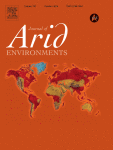Ver ítem
- xmlui.general.dspace_homeCentros Regionales y EEAsCentro Regional Patagonia SurEEA Santa CruzArtículos científicosxmlui.ArtifactBrowser.ItemViewer.trail
- Inicio
- Centros Regionales y EEAs
- Centro Regional Patagonia Sur
- EEA Santa Cruz
- Artículos científicos
- Ver ítem
Monitoring drylands: The MARAS system
Resumen
MARAS (Monitoring of Arid and Semiarid Regions) consists of 379 ground monitors in Patagonia, a 624.500 km2 semiarid area of southern Argentina and Chile. The objective of this paper was to describe the system and analyze four variables of the initial data base. Floristic composition, diversity and cover were analyzed with intercept lines (500 points). Patches (resource-sinks areas) and Interpatches (areas that loose resources) were described using Gap
[ver mas...]
MARAS (Monitoring of Arid and Semiarid Regions) consists of 379 ground monitors in Patagonia, a 624.500 km2 semiarid area of southern Argentina and Chile. The objective of this paper was to describe the system and analyze four variables of the initial data base. Floristic composition, diversity and cover were analyzed with intercept lines (500 points). Patches (resource-sinks areas) and Interpatches (areas that loose resources) were described using Gap intercept lines (50 m). Eleven Landscape Functional Analysis indicators were recorded in 10 interpatches: Soil stability, Infiltration and Nutrient cycling. Vegetation Cover was 43 ± 2%, Richness 15 ± 7 species/monitor, Interpatch Size 154 ± 134 cm and LFA Stability Index 46 ± 1%. Cover, Richness and Stability maps had bimodal distribution and maximum in S and NE areas, following rainfall gradients. Variability analysis shows that cover estimations are within 5% error at site and regional scales. Graphical analysis of single monitors shows observational biases in interpatch size and LFA Stability index. Richness estimations correlate significantly with α diversity (R2 = 0.80). Analysis of 5-year change in 115 monitors shows significant reductions in cover and interpatch length, especially N of the region. These base line evaluations enable analysis of future changes that were not possible with multiple techniques and isolated data bases.
[Cerrar]

Fuente
Journal of Arid Environments Available online 9 November 2018
Fecha
2018-11-09
Editorial
Elsevier
ISSN
0140-1963
1095-922X
1095-922X
Formato
pdf
Tipo de documento
artículo
Palabras Claves
Derechos de acceso
Embargado
 Excepto donde se diga explicitamente, este item se publica bajo la siguiente descripción: Creative Commons Attribution-NonCommercial-ShareAlike 2.5 Unported (CC BY-NC-SA 2.5)
Excepto donde se diga explicitamente, este item se publica bajo la siguiente descripción: Creative Commons Attribution-NonCommercial-ShareAlike 2.5 Unported (CC BY-NC-SA 2.5)

